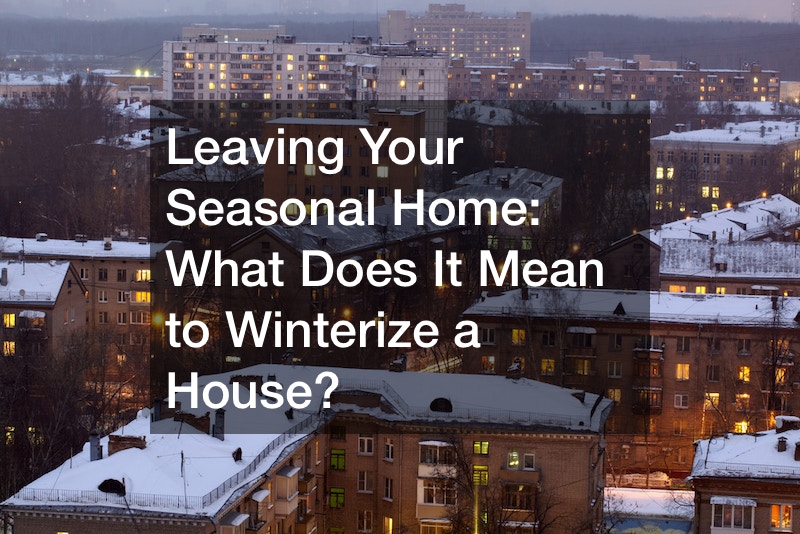
If you spend time between two residences, knowing how to winterize your home is in your best interest. This practice will ensure your space is fully functional when you return during spring. The winterization process primarily involves preparing the home for the winter months when it’ll be vacant.
You’ll typically want to take these preventive measures in the fall. Staying proactive will protect you against damage from issues like bursting water pipes, among many others. So, what does it mean to winterize a house? Read on to find out.

1. Turn Off the Water Supply
Shutting off your water supply is one of the best things you can do for your home, especially if you’ll be gone the entire winter. You’re sure to find it when looking for an answer to ‘What does it mean to winterize a house.’ Don’t make the mistake of leaving the water on when lines aren’t being used. It can leave you with leaks or burst pipes requiring extensive plumbing repair from a professional plumbing contractor.
Turn off your water at the main valve, which you’ll typically find outside. If your home relies on a well, just shut the breaker to the pump. If you don’t intend to turn off the water supply, ensure some water is running through the pipes.
The easiest way to do this is by turning on the closest fixture to the point where water enters the house and another at the furthest point within the home. This will ensure a steady trickle. The water must be running continuously to avoid issues.
2. Drain Out Your Waterlines
You don’t want any water left in your pipes. Standing water could freeze and expand, causing issues that necessitate broken water line repair. So, as you ponder ‘what does it mean to winterize a house,’ empty your waterlines.
You may wonder, ”How do I even do this?” It’s quite easy. All you need to do is open every faucet and flush the toilets. Run the water until it starts to trickle slowly.
Flush the toilets again to clear the bowls after emptying the tanks. Drain your pressure tank if your water source is a well. Empty your water heater as well if you’re going to turn off the pilot light. While at it, inspect for the need for water heater repairs.
3. Insulate the Pipes
One of the top concerns for most homeowners searching for ‘what does it mean to winterize a house’ is protecting their home’s plumbing and with good cause! It’s unquestionably one of the most crucial jobs to complete before leaving your home vacant, particularly if the temperature drops below freezing. Begin with the outdoor plumbing, including the irrigation systems like the sprinkler systems, faucets, and hoses.
Turn off the water supply to these lines and drain the water before winter starts. An irrigation consultant in your area can assist you if you’d prefer not to risk any harm and want to rely on an expert. You should also cut off the water supply and drain your faucets for your indoor pipes.
For more vulnerable pipes, such as those in the attic or exterior wall, purchase insulation materials at your neighborhood hardware shop. You can either opt for polyethylene or fiberglass. Consider leaving your thermostat above freezing so your home doesn’t get cold enough for the pipes to freeze.
4. Prepare Your Outdoor Space
As you look for an answer to ‘What does it mean to winterize a house,’ note that you’ll need to save most of your time for the yard as it might be the most labor-intensive aspect of the winterization process. Start by gathering any fallen leaves or branches with a rake so you can mow your lawn one last time before you leave, if necessary. Cut any dead tree limbs to prevent roof damage in the event of a storm while you’re away.
If you have a pool, winterize it by emptying it partially and covering it to keep out debris and bugs. Bring out your ladder. You’ll need it to clean the gutters. Clogged gutters can expose your roof and house to water damage when it rains or snows. Clear any obstructions in your gutters.
Secure the downspouts to ensure water from heavy rains drains away from the home. Consider hiring a local gutter cleaning expert for help with this task. Remember to prepare your sprinkler system by shutting off the water and timer, emptying it, and insulating the above-ground components.
While at it, consider making some aesthetic upgrades. For example, you can add custom signage to the yard. For a personal touch, have the sign spell out your family name. This way, anyone who walks by will know who the home belongs to.

5. Secure Your Home’s Exterior
Since you’re going to be gone for a while, you want to secure your home so what’s outside doesn’t get inside, a great answer to ‘What does it mean to winterize a house.’ During a winter storm, even something as minor as a damaged window can result in considerable water damage. First, check the weatherstripping on the doors and windows.
If it’s worn out, it can let in pests, rain, and cold air, which can cause pipes to freeze and reduce your home’s energy efficiency. The only solution here is to get a replacement. If you reside in a storm-prone location, installing storm windows or covering your windows with plywood will provide an extra layer of protection.
Remember to lock all doors and windows before you leave. Shut all the shutters. Properly store outdoor furniture and décor inside a shed or garage for the season. Use weatherproof covers for furniture that you can’t store.
6. Prepare the HVAC System
Once you’re sure you won’t need the AC for the rest of the season, turn off the electrical circuit that powers the unit. This stops the AC from unintentionally turning on in the winter.After spending the whole summer outside, your air conditioner is likely covered in pine needles, leaves, dirt, dust, and other debris. A quick hose down is all you need to clean the unit. Choose a warm fall or winter day to carry out this task to prevent the water from freezing on the metal.
While outdoor air conditioners are made to withstand inclement weather, such as heavy snow, rain, and ice fall. Therefore, covering them in the winter isn’t necessary. However, feel free to cover your air conditioner with a commercially available cover if you’re concerned about drifting snow, falling icicles, and other physical hazards. Alternatively, you can throw plywood on top of the appliance and weigh it down with a stone or rock.
Next, open the air vents and clean them. Clean dirty supply and return registers with your vacuum’s brush attachment. Then, to maintain optimum system balance, ensure at least 80% of the vents are always open and unobstructed.
Change the air filters to encourage proper airflow. With each season change, carry out this task to ensure the filter doesn’t become clogged, causing your HVAC system to strain to maintain comfort. You should also set aside some time to prep the furnace. Inspect for any indicators of underlying issues, such as excessive dust accumulation or crooked flue pipes. To avoid creating a fire hazard, clean the area surrounding the unit as necessary and remove anything kept in your utility closet.
You’ll also want to adjust your thermostat settings to accommodate your home’s needs for the winter. To maximize savings, reduce the temperature by at least 10 degrees for the time when you’ll be away. If you set your thermostat correctly, it will automatically adjust to a pleasant temperature right before you get back.
While these steps will get you far and reduce your likelihood of needing emergency HVAC repair in the middle of winter, it’s still a good idea to schedule professional HVAC inspection and maintenance with a heating company. Do this every fall for the furnace and in the spring for the AC. These professionals understand ‘what does it mean to winterize a house.’ This way, you’ll be sure the heating system is in optimal working condition before your home needs it most.

7. Schedule a Roof Inspection
While you could conduct the roof inspection yourself, a professional local roof repair service is best placed to assess your roof and address any underlying issues before the cold winter months set in. They’ll look for damage to the flashing and shingles. Roofers have all the tools needed to inspect roof sections, like the sealant on the vents and the valleys. They can answer any question about ‘what does it mean to winterize a house.’ On top of that, they come equipped with safety equipment that makes ascending and descending your roof much safer.
Roof inspections are typically conducted in the spring. However, waiting until then to make the necessary plans may land you on a long waiting list. This can be inconvenient if it disrupts your schedule. You can beat the rush and have seasoned roofers on your property for an inspection before winter by making an appointment right now. By doing so, the professionals will have enough time to take necessary actions before it gets too cold.
Remember, an inspection is only effective if you act on what it reveals. Warm weather is the best time to address roofing needs, which also applies to home exterior work like siding installations. Winter makes things more challenging, and fixes are often not as effective. By starting your repair efforts as soon as possible, you can ensure they’re completed correctly, and your roof is prepared to take on winter.
8. Check Your Carbon Monoxide Detectors, Smoke Alarms, and Security System
Before leaving, get your ladder and check your carbon monoxide and smoke detectors to confirm whether the current batteries will last through winter. You also want to ensure the security system is operational and set accordingly. A homeowner’s biggest nightmare is a break-in (or worse, a hazardous house fire or gas leak).
With these alarm systems, you can enjoy much-deserved peace of mind while away for the season. If you’re financially capable, install smart device alarms in your house so that you’ll be notified by phone if something goes wrong. You can then ask a trusted friend or neighbor to check the property.
9. Clean Out Your Fridge
While it may not be the first thing you come across when searching for ‘what does it mean to winterize a house” you should remove any foods from your fridge since you won’t be in the home for a while and then clean it and unplug once you’re done. You’ll want to leave the freezer and refrigerator doors open. Closing it up will cause the fridge to develop a foul smell and encourage the growth of mold and mildew due to the residual moisture. You don’t want this. If you plan to leave any food behind (ideally, you shouldn’t), store it in air-tight containers so pests don’t end up ”throwing a party” and feed off it throughout winter. If rodents and insects are a problem, consider using pesticides or set traps to keep them out.
10. Hold Your Mail
You’ve been getting mail at this address for a while. Consider whether you’ll be better off holding or forwarding it to the home you’ll be living in for the next couple of months. If you’re planning to be away longer than the USPS’s 30-day holding period, you may want to use the USPS Forward Mail service to have your mail delivered to your seasonal address.

11. Give Your Home One Last Thorough Cleaning
You could get your hands dirty or hire a professional housecleaner for this part. Whatever you decide, ensure you vacuum the entire home, wipe down surfaces, and wash bedding. You can also pour some bleach in your toilet bowl to prevent mold and mildew growth.
You can now satisfactorily say you have an answer to the question ‘What does it mean to winterize a house?’ There’s a lot involved, but it all comes down to preparing your home for the freezing winter temperatures, which can be harsh. This read explores the process in detail. Remember, starting as early as possible is the key to ensuring your winterization efforts are effective. Preferably, kick things off in early fall.




